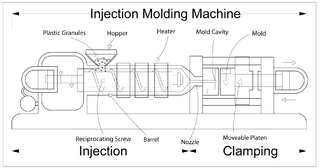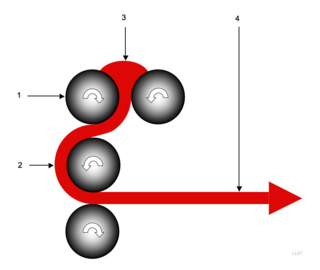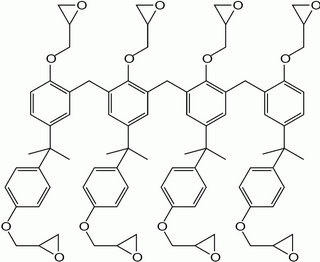Rheology is the study of the flow of matter, primarily in a liquid state, but also as "soft solids" or solids under conditions in which they respond with plastic flow rather than deforming elastically in response to an applied force. It is a branch of physics which deals with the deformation and flow of materials, both solids and liquids.

Heat treating is a group of industrial and metalworking processes used to alter the physical, and sometimes chemical, properties of a material. The most common application is metallurgical. Heat treatments are also used in the manufacture of many other materials, such as glass. Heat treatment involves the use of heating or chilling, normally to extreme temperatures, to achieve a desired result such as hardening or softening of a material. Heat treatment techniques include annealing, case hardening, precipitation strengthening, tempering, carburizing, normalizing and quenching. It is noteworthy that while the term heat treatment applies only to processes where the heating and cooling are done for the specific purpose of altering properties intentionally, heating and cooling often occur incidentally during other manufacturing processes such as hot forming or welding.

Injection moulding is a manufacturing process for producing parts by injecting molten material into a mould. Injection moulding can be performed with a host of materials mainly including metals,, glasses, elastomers, confections, and most commonly thermoplastic and thermosetting polymers. Material for the part is fed into a heated barrel, mixed, and injected (Forced) into a mould cavity, where it cools and hardens to the configuration of the cavity. After a product is designed, usually by an industrial designer or an engineer, moulds are made by a mould-maker from metal, usually either steel or aluminium, and precision-machined to form the features of the desired part. Injection moulding is widely used for manufacturing a variety of parts, from the smallest components to entire body panels of cars. Advances in 3D printing technology, using photopolymers which do not melt during the injection moulding of some lower temperature thermoplastics, can be used for some simple injection moulds.

An O-ring, also known as a packing, or a toric joint, is a mechanical gasket in the shape of a torus; it is a loop of elastomer with a round cross-section, designed to be seated in a groove and compressed during assembly between two or more parts, creating a seal at the interface.
Fibre-reinforced plastic (FRP) is a composite material made of a polymer matrix reinforced with fibres. The fibres are usually glass, carbon, aramid, or basalt. Rarely, other fibres such as paper, wood, or asbestos have been used. The polymer is usually an epoxy, vinylester, or polyester thermosetting plastic, though phenol formaldehyde resins are still in use.

A calender is a series of hard pressure rollers used to finish or smooth a sheet of material such as paper, textiles, or plastics. Calender rolls are also used to form some types of plastic films and to apply coatings. Some calender rolls are heated or cooled as needed. Calenders are sometimes spelled calendars.
A coating is a covering that is applied to the surface of an object, usually referred to as the substrate. The purpose of applying the coating may be decorative, functional, or both. The coating itself may be an all-over coating, completely covering the substrate, or it may only cover parts of the substrate. An example of all of these types of coating is a product label on many drinks bottles- one side has an all-over functional coating and the other side has one or more decorative coatings in an appropriate pattern to form the words and images.

Microcellular plastics, otherwise known as microcellular foam, is a form of manufactured plastic, specially fabricated to contain billions of tiny bubbles less than 50 microns in size. This type of plastic is formed by dissolving gas under high pressure into various polymers, relying on "thermodynamic instability phenomena" to cause the uniform arrangement of the gas bubbles, otherwise known as nucleation. Its main purpose was to reduce material usage while maintaining valuable mechanical properties. The main room for variance in these foams is the gas used to create them; the density of the finished product is determined by the gas used. Depending on the gas used, the density of the foam can lie between 5% and 99% that of the pre-processed plastic. Design parameters, focused more on the final form of the foam and the molding process afterward, include the type of die or mold to be used, as well as the dimensions of the bubbles, or cells, that classify this material as a foam. Since the size of cells is close to the wavelength of light, to the casual observer this foam retains the appearance of a solid light colored plastic.
Metal rubber is a broad, informal name for several conductive plastic polymers with metal ions produced by NanoSonic, Inc, in cooperation with Virginia Tech. This self-assembling nanocomposite is flexible and durable to high and low pressures, temperatures, tensions, most chemical reactions, and retains all of its physical and chemical properties upon being returned to a ground state. NanoSonic’s Metal Rubber™ is an electrically conductive and flexible elastomer. It can be mechanically strained to greater than 1000 percent of its original dimensions while remaining electrically conductive. As Metal Rubber can carry data and electrical power and is environmentally rugged, it has use as a flexible and stretchable electrical conductors in the aerospace/defense, electronics and bioengineering markets.
Silicone rubber is an elastomer composed of silicone—itself a polymer—containing silicon together with carbon, hydrogen, and oxygen. Silicone rubbers are widely used in industry, and there are multiple formulations. Silicone rubbers are often one- or two-part polymers, and may contain fillers to improve properties or reduce cost.
Silicone rubber is generally non-reactive, stable, and resistant to extreme environments and temperatures from -67 °F to 572 °F while still maintaining its useful properties.
Due to these properties and its ease of manufacturing and shaping, silicone rubber can be found in a wide variety of products, including: voltage line insulators,
automotive applications; cooking, baking, and food storage products; apparel such as undergarments, sportswear, and footwear; electronics; medical devices and implants; and in home repair and hardware with products such as silicone sealants.

SU-8 is a commonly used epoxy-based negative photoresist. Negative refers to a photoresist whereby the parts exposed to UV become cross-linked, while the remainder of the film remains soluble and can be washed away during development.

Nitriding is a heat treating process that diffuses nitrogen into the surface of a metal to create a case-hardened surface. These processes are most commonly used on low-carbon, low-alloy steels. They are also used on medium and high-carbon steels, titanium, aluminium and molybdenum. In 2015, nitriding was used to generate unique duplex microstructure, known to be associated with strongly enhanced mechanical properties
Thermomechanical analysis (TMA) is a technique used in thermal analysis, a branch of materials science which studies the properties of materials as they change with temperature.
Microthermoforming is the abbreviation for microscopic or microscale thermoforming, or, more precisely, for thermoforming of microproducts or microstructure products. Microstructure products means products that have structures in the micrometre range and have their technical function provided by the shape of the microstructure [1]. Thermoforming [2] in turn means shaping of heated and therefore softened semi finished products in the form of thermoplastic polymer films or plates with their edges fixed by three-dimensional stretching. Shaping is carried out mainly by forming the films or plates into female moulds or over male moulds. While the other polymer microreplication processes such as micro injection moulding or (vacuum) hot embossing are primary forming processes where forming occurs already in a molten, liquid phase of the heated polymer material, microthermoforming is a secondary forming process where forming occurs in a strongly softened, but still solid phase of the heated polymer.

Electron-beam processing or electron irradiation (EBI) is a process that involves using beta radiation, usually of high energy, to treat an object for a variety of purposes. This may take place under elevated temperatures and nitrogen atmosphere. Possible uses for electron irradiation include sterilization and cross-linking of polymers.

Solid is one of the four fundamental states of matter. In solids molecules are closely packed. It is characterized by structural rigidity and resistance to changes of shape or volume. Unlike liquid, a solid object does not flow to take on the shape of its container, nor does it expand to fill the entire volume available to it like a gas does. The atoms in a solid are tightly bound to each other, either in a regular geometric lattice or irregularly. Solids cannot be compressed with little pressure whereas gases can be compressed with little pressure because in gases molecules are loosely packed.

Plastic film is a thin continuous polymeric material. Thicker plastic material is often called a “sheet”. These thin plastic membranes are used to separate areas or volumes, to hold items, to act as barriers, or as printable surfaces.
Crystallization of polymers is a process associated with partial alignment of their molecular chains. These chains fold together and form ordered regions called lamellae, which compose larger spheroidal structures named spherulites. Polymers can crystallize upon cooling from the melt, mechanical stretching or solvent evaporation. Crystallization affects optical, mechanical, thermal and chemical properties of the polymer. The degree of crystallinity is estimated by different analytical methods and it typically ranges between 10 and 80%, thus crystallized polymers are often called "semi-crystalline". The properties of semi-crystalline polymers are determined not only by the degree of crystallinity, but also by the size and orientation of the molecular chains.
Thermoplastics containing short fiber reinforcements were first introduced commercially in the 1960s. The most common type of fibers used in short fiber thermoplastics are glass fiber and carbon fiber
. Adding short fibers to thermoplastic resins improves the composite performance for lightweight applications. In addition, short fiber thermoplastic composites are easier and cheaper to produce than continuous fiber reinforced composites. This compromise between cost and performance allows short fiber reinforced thermoplastics to be used in myriad applications.













